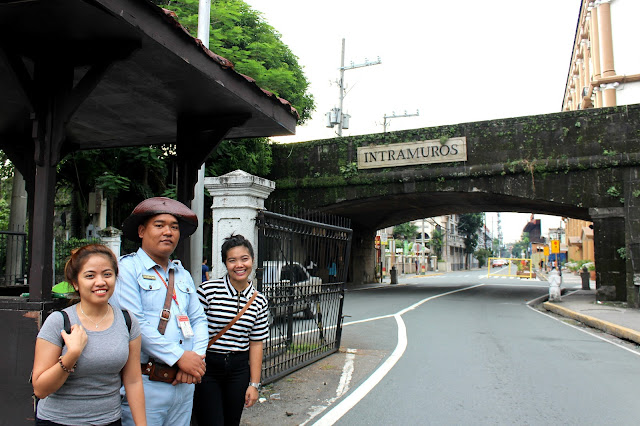
You might be thinking about the location where this photo taken from; I have no money to travel abroad so it's not from the ancient Greece or Rome. It is one of the tourist spots and must visit attractions in Manila. Okay, it is from Intramuros or the "Walled City" one of the sites that has significance in Philippine history. I was captivated by the Intramuros Open House in Celebration of World Tourism Day. Entrance fees are for free on three of the must visit spots inside the walled city; these are Fort Santiago, Baluarte de San Diego, and Casa Manila. Not only that, there are free bicycle tour at Plaza Roma, and picnic with performance grounds, food and art at Baluarte de San Diego.
My route to Intramuros was a bit challenging because I came from LRT Recto and LRT 1 to Rizal Park. Instead of taking the streets nearby the National Museum I passed by the long stretch of the highway from Kilometer 0 passing Manila Hotel and Port area to the entrance near Fort Santiago.

Fort Santiago is one of the oldest fortifications in Manila. Built in 1571, on the side of the native settlement of Raja Soliman. First fort was a palisaded structure of logs and earth. Destroyed in the Limahong attack in 1574. Stone fort built between 1589 and 1592. Damaged in the 1645 earthquake. Repaired and strengthened from 1658 to 1663. Became the headquarters of the British occupation army from 1762 to 1764. Repaired and renovated in 1778.

Former headquarters of the Philippine Division of the U.S. Army. Occupied by the Japanese military in 1942 where hundreds of civilians and guerillas were imprisoned, tortured and executed. Destroyed in the Battle of Manila in 1945. Used as depot of the U.S. Transportation Corps before turnover to the Philippine Government in 1946. Declared Shrine of Freedom in 1950. Restoration and maintenance of the fort began in 1951 under the National Park Development Committee. Management was turned over to the Intramuros Administration in 1992.

It is really hard take photos inside Fort Santiago due to people taking their own photos in every corner, that's the disadvantage of having a free entrance but it's fine, still nice to see people having interest about historical artifacts. After satisfying myself on the walls and spots inside the Fort, left and proceeded to my next destination while the rains started dropping. Next is Plaza Roma where the grand Manila Cathedral is situated.

Formerly called Plaza Mayor. Converted into a park in 1797. Renamed Plaza McKinley after U.S. President William McKinley in 1901. Renamed Plaza de Roma in 1961 to honor Sacred College of Cardinals in Rome following elevation of first Filipino cardinal, Rufino J. Santos. Bronze monument to Carlos IV of Spain erected in 1824 as a tribute for the introduction of the smallpox vaccine in the Philippines. Fountain built in 1886. Statue replaced by Gomburza monument in the 1960s. Statue returned in 1981.

Using google map I walked on the streets to the spot where San Agustin Church and Casa Manila are located. There was a wedding in San Agustin, as respect, I didn't attempt to enter the oldest church in the Philippines. Also, I chose not to enter Casa Manila Museum because there were a lot of visitors inside. Still using my google map, I proceeded to the highlight of my travel - Baluarte de San Diego, just few meters away from San Agustin.

In this baluarte is the oldest stone fort in Manila. Built in 1586 it was called the Nuestra Senora de Guia. Designed by Jesuit priest Antonio Sedeno. Fell into disrepair and renovated in 1593. Incorporated as part of the walls but later abandoned due to its unstable foundations. baluarte constructed with orillons (curved corners) masking cannons on the flanks. Destroyed during the British invasion in 1762. Repaired and renovated in 1764. American Army ordinance section built on site during American occupation. Destroyed during World War 2 and is now a major tourist attraction of the Walled City.
My first step inside the walls of Intramuros was in 2012 and finally after five years, I was able to complete all parts of the walled city. Because of this free entrance, I am happy to know that a lot of Filipinos are still interested about the history of the country. I am hoping that moving forward NCCA, Intramuros Management, National Museum and other organization in charge of the artifacts and historical spots will let the Filipinos witness the ancient wonders without entrance fee.
